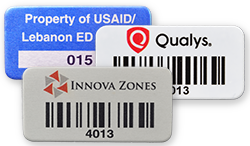Tough Enough for All Your Stuff
Economically Priced with Satisfaction Guaranteed
Super Fast Delivery
 View Gallery
View Gallery
 View Gallery
View Gallery
Also called asset tags, property identification labels enable property to be tracked and protected.
In tough times, scrupulous asset management is more critical than ever. The purpose of the property manager is to extract the greatest possible value from each asset. Loss, damage or underutilization cuts dangerously into profit margin. Every investment must be fully realized.
Property identification labels are the basis for cataloging and tracking assets — furniture, electronics, equipment, tools, vehicles and hardware. To each piece of property a considerable amount of data can be attached.
To maximize utility many automated procedures can be tied to this data. In a complex corporate framework such automation can significantly reduce the cost of operations and improve its profitability in the long-term. When new assets are acquired, put into service or disposed of, complex financial calculations can be made. When personnel begin or cease employment, resources can be automatically reallocated. When unused, assets might be queued for maintenance or loaned out.
Complicated, lengthy projects like the construction of a building often require numerous expensive assets. Earth movers, forklifts, power tools, laptops-and even down to clip boards and hard hats-all might be carefully tracked to manage the cost of the project simply by affixing property identification labels and regularly recording asset logistics.
Should an item turn up missing its usage might be narrowed to an isolated task, a specific day, or a certain individual. With this digital trail, a judgement of loss, theft or destroyed can then be determined and acted upon, legally or financially.
Damaged assets might be tracked to specific task or event which requires procedural evaluation or special consideration when assessing and quoting a project. Monitoring tool damage might also uncover negligent or undertrained employees and lead to an improved workforce.
Tracking assets on the job site also yields valuable historical data for calculating the viability of past projects. The future of a business is often set based on such reports.
Location and condition are important data attached to moveable assets. Tools and equipment shift within the scope of business operations. Between bar code scans their disposition can be carefully controlled to maximize utility and lifespan. It is possible, through scalable asset management, to expand this realm of control beyond the business' normal operations.
For instance, Hospital A loans Hospital B an expensive hemodialysis machine. The asset management system of both hospitals is either linked or the former has access to the latter. When the equipment leaves custody of its owner a barcode scan records its location. When it arrives at Hospital B it receives an entry scan which confirms a successful transit. During its adventures in various departments the machine is regularly tracked so that both facilities can monitor aggregate usage. This tight control also helps prevent this expensive asset from becoming lost in the chaos of a busy medical facility. Ultimately the quality of asset management between both facilities provides operational data which helps determine the viability of their partnership.
Creating an asset management system is the key to wringing every drop of value out of each asset. At the forefront of this effort is the studious property manager and his army of property identification labels.
Alliance Tag manufacturers a variety of standard and custom property identification labels designed to help businesses maximize their investments.